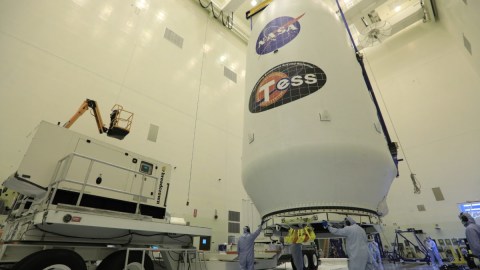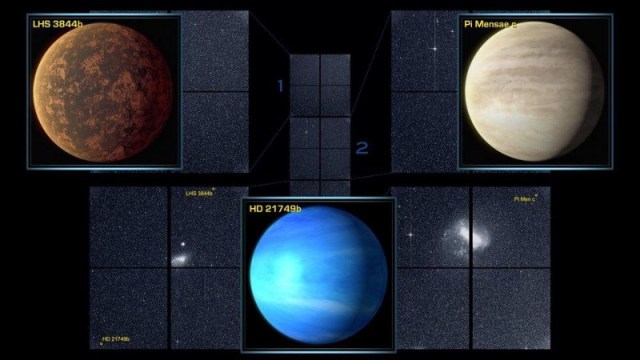Here’s what the new TESS telescope has already discovered

NASA/Kim Shiflett
- The Kepler program closed down in August, 2018, after nine and a half years of observing the universe.
- Picking up where it left off, the Transiting Exoplanet Survey Satellite (TESS) has already found eight planets, three of which scientists are very excited about, and six supernovae.
- In many ways, TESS is already outperforming Kepler, and researchers expect it to find more than 20,000 exoplanets over its lifespan.
In 2009, we only knew of the existence of 350 exoplanets, or planets outside of our solar system. Then, NASA launched the Kepler space telescope, and all of that changed. Over its 9-and-a-half-year lifespan, the telescope identified 2,720 exoplanets. We learned that every star is orbited by at least one planet on average, we learned more about the evolution and fates of planets as they orbit their star, and we even found a number of planets that might support life.
But nothing lasts forever. On October 30, 2018, NASA announced that the productive spacecraft had run out of the fuel it needed to continue its scientific mission. That doesn’t mean that the hunt for other worlds is over, however.
In partnership with SpaceX, NASA launched the Transiting Exoplanet Survey Satellite (TESS) on April 18, 2018, to pick up where Kepler left off. And it’s off with a bang. In only its first four months of observing the stars, TESS found eight confirmed planets and 320 candidates. Over the course of its two-year mission, NASA expects TESS to find more than 20,000 exoplanets, most of them between 30 and 300 light years away, a hop and a skip away in galactic terms. What’s more, the moon’s gravity helps keep TESS in stable orbit — its fuel reserves will be used just to orient the telescope towards its targets, meaning TESS could theoretically stay in orbit for 300 years.
What can TESS find?
TESS picks planets out of the sky by monitoring the brightness of stars in its field of view. As a planet transits in front of a star, the star dims slightly. By using the data on how much a star dims, the TESS program can extrapolate the size and mass of an exoplanet (hence its name, the Transiting Exoplanet Survey Satellite). TESS data can even be spectrally analyzed to determine the elements in a planet’s atmosphere, and scientists can also use the simple sensors to extrapolate more complicated planetary features, like its radiation, temperature, the presence of clouds, and others.

An artist’s depiction of Pi Mensae c, which has the same density as water.
NASA
What has TESS found?
To date, TESS has found eight exoplanets, three of which merit a closer look. There’s Pi Mensae c, which is 2.14 times the size of Earth and about as dense as water. Researchers believe that the planet has a core of iron and rock surrounded by an ocean or an atmosphere of water, hydrogen, methane, and/or helium. But the strangest feature of this planet is that there’s another planet in its system, Pi Mensae b, that is 10 times as massive as Jupiter and is swinging around its star in a very eccentric orbit, while Pi Mensae c has a tight, circular orbit. Normally, a planet like this would have gained its eccentric orbit by colliding with a nearby planet — likely Pi Mensae c in this case — but its watery sister planet remains.
Then, there’s HD 21749 b orbiting a K-type star slightly smaller than the sun. HD 21749 b is a mere 52 light years away, and it has the longest orbiting period of any planet within 100 light years outside of our solar system at 36 days. These kinds of planets are particularly hard to find since they don’t transit in front of their star as frequently, making this a valuable planet to know of for future research. Most exciting though, are hints that this system may hold another planet roughly the size of Earth.

The side of the LHS 3884 b facing its star has pools of molten lava.
NASA
LHS 3884 b, the third planet of note TESS found, is likely covered in molten lava. Although its star is a relatively cool red dwarf, LHS 3884 b orbit is so close that the planet likely has a surface temperature of around 540°C, or 1,004°F. LHS 3884 b orbits around its star in just 11 hours.
Looking for more than just planets
While it’s primarily looking for planets, there’s far too much happening in the universe for TESS not to notice. TESS has observed flare stars, binary stars, supernovae, and other astronomical phenomena. In fact, where Kepler only observed six supernovae in its first four years, TESS has observed as many in its first month.
George Ricker, the principal investigator of the TESS mission, laid out exactly how exciting TESS has been:
We’re only halfway through TESS’s first year of operations, and the data floodgates are just beginning to open. […] When the full set of observations of more than 300 million stars and galaxies collected in the two-year prime mission are scrutinized by astronomers worldwide, TESS may well have discovered as many as 10,000 planets, in addition to hundreds of supernovae and other explosive stellar and extragalactic transients.
With the program this early in its infancy, we can expect many more findings in the years to come.





